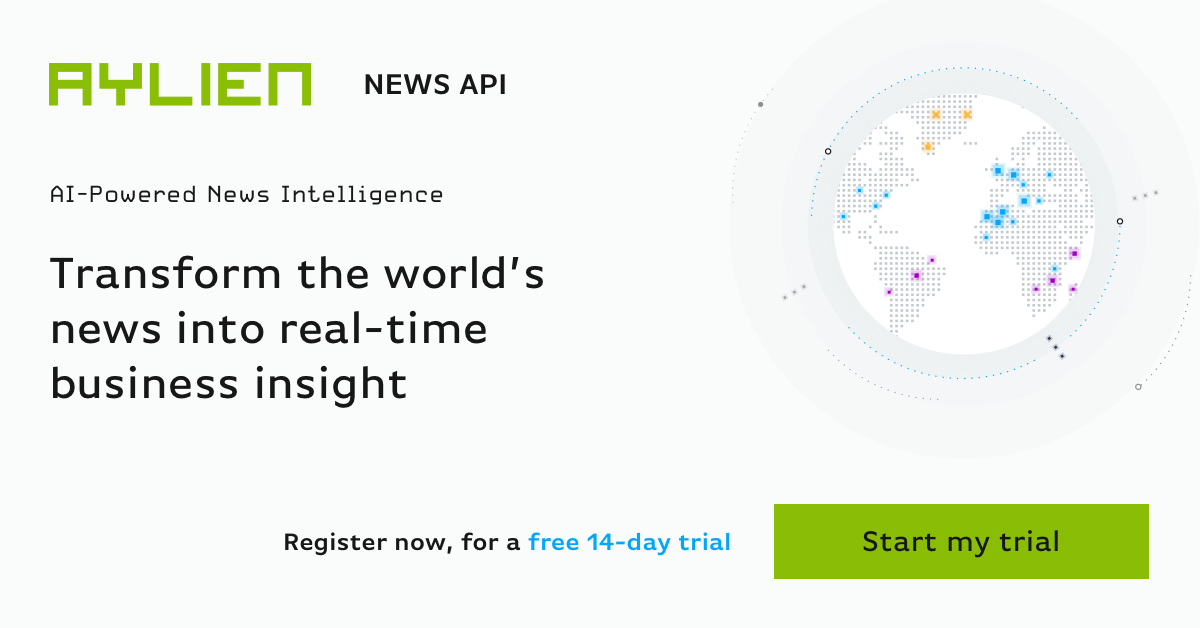This blog is part of a series, AYLIEN NEWS API: A Starter Guide for Python Users. You can view the Jupyter Notebook learner document here.
News Intelligence can be the difference for large organisations to identify risks and opportunities early, allowing them to take quick and decisive action when needed. Often, all that is needed is one news story, one needle in the haystack to trigger an alarm or to identify a gap in the market.
But the huge volume and incessant nature of news is such that we need to analyse data at an aggregate level before identifying a need to drill down and analyse at the minutiae of individual news stories. By their nature, some articles will cover the same event and relate the same information. Consequently, sometimes we will want to interrogate news at a macro level and analyze overall trends rather than querying granular stories.
AYLIEN’s Timeseries endpoint empowers us to do this. With this endpoint, we can track changes in quantitative values contained in stories over time. This information can be anything from mentions of a topic or entities, sentiment about a topic, or the volume of stories published by a source, to name but a few. It is also much faster to pull aggregate Timeseries data then it is to query the stories endpoint and return individual stories in batches and subsequently process them to measure the occurrences of entities, sentiment etc. contained in each article.
Querying the Timeseries Endpoint
The Timeseries endpoint retrieves the stories that meet our search criteria and aggregates per minute, hour, day, month, or however you see fit. This can be very useful for identifying spikes or dips in news volume relating to a subject of interest. By default, AYLIEN’s News API will aggregate the volume of stories per day.
The output of a Timeseries query is a nested JSON object that lists the volume of stories per day in an array. We can convert this to a Pandas dataframe to make it more easily legible to the human eye.

Visualizing Timeseries
Visualizing Timeseries data is a quick and efficient way for identifying spikes, anomalies or other points of interest and is a great springboard for identifying areas of further investigation using granular stories.

However, before deep diving into the minutiae of stories, we can identify one story per period of interest to give us an indication of the context of news coverage. Using the Stories endpoint, we can then extract the highest Alexa ranked story for the corresponding time period. Appending the title of this article to our graph gives us a good indication of the focus of the content. Alexa Ranking is an estimate of a site's popularity on the internet. Learn more about working with Alexa Ranking here.

This utilization of the Timeseries and Stories endpoints combine to make a simple and effective toolkit for quickly analyzing news coverage. Check out how we used timeseries to analyse coverage of the US Democratic candidates here.
Pulling Timeseries by Sentiment
In Media Monitoring, sentiment analysis is an invaluable tool for tracking brand sentiment, the success of campaigns, public relations and monitoring crises. It can act as the acid test for public opinion and serve as a vital indicator of how a subject is perceived.
With the Timeseries endpoint, we can aggregate the stories that meet our search criteria and analyse their sentiment en masse. While AYLIEN’s News API classifies documents and entities as having a positive, negative or neutral sentiment, focusing on the polarised positive and negative stories only gives us a better indication if a subject is being viewed in a good or bad light.

Check out how we used sentiment analysis and the timeseries endpoint to analyse how Brexit and Oscar nominated movies were received by the media.
This blog is part of a series, AYLIEN NEWS API: A Starter Guide for Python Users. You can view the Jupyter Notebook learner document here.
Other Blogs in the series:
Starter Guide 1: AYLIEN’s Story Object - a Primer on NLP Enrichment and How to Use it
Starter Guide 2: Refining Your News API Query
Starter Guide 4: How To Use The News API Trends Endpoint
Starter Guide 5: Starter Guide 5: How to Use the News API Clusters Endpoint
Related Content
-
 General
General20 Aug, 2024
The advantage of monitoring long tail international sources for operational risk

Keith Doyle
4 Min Read
-
 General
General16 Feb, 2024
Why AI-powered news data is a crucial component for GRC platforms

Ross Hamer
4 Min Read
-
 General
General24 Oct, 2023
Introducing Quantexa News Intelligence

Ross Hamer
5 Min Read
Stay Informed
From time to time, we would like to contact you about our products and services via email.

